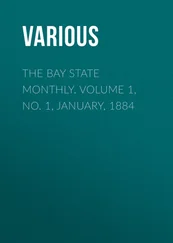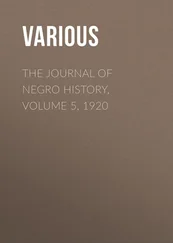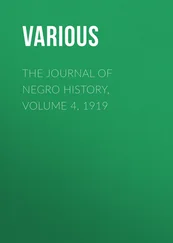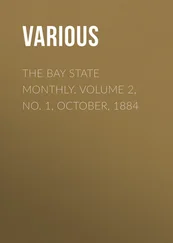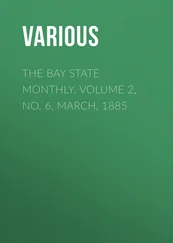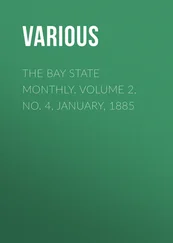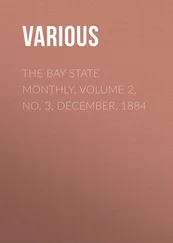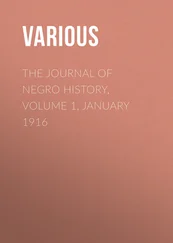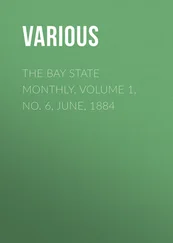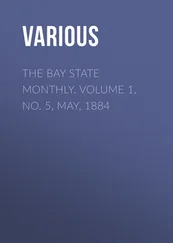Various - The Bay State Monthly, Volume 3, No. 2
Здесь есть возможность читать онлайн «Various - The Bay State Monthly, Volume 3, No. 2» — ознакомительный отрывок электронной книги совершенно бесплатно, а после прочтения отрывка купить полную версию. В некоторых случаях можно слушать аудио, скачать через торрент в формате fb2 и присутствует краткое содержание. Жанр: foreign_antique, periodic, foreign_edu, на английском языке. Описание произведения, (предисловие) а так же отзывы посетителей доступны на портале библиотеки ЛибКат.
- Название:The Bay State Monthly, Volume 3, No. 2
- Автор:
- Жанр:
- Год:неизвестен
- ISBN:нет данных
- Рейтинг книги:3 / 5. Голосов: 1
-
Избранное:Добавить в избранное
- Отзывы:
-
Ваша оценка:
- 60
- 1
- 2
- 3
- 4
- 5
The Bay State Monthly, Volume 3, No. 2: краткое содержание, описание и аннотация
Предлагаем к чтению аннотацию, описание, краткое содержание или предисловие (зависит от того, что написал сам автор книги «The Bay State Monthly, Volume 3, No. 2»). Если вы не нашли необходимую информацию о книге — напишите в комментариях, мы постараемся отыскать её.
The Bay State Monthly, Volume 3, No. 2 — читать онлайн ознакомительный отрывок
Ниже представлен текст книги, разбитый по страницам. Система сохранения места последней прочитанной страницы, позволяет с удобством читать онлайн бесплатно книгу «The Bay State Monthly, Volume 3, No. 2», без необходимости каждый раз заново искать на чём Вы остановились. Поставьте закладку, и сможете в любой момент перейти на страницу, на которой закончили чтение.
Интервал:
Закладка:
"Cheever and Lovell and Gardner, the Puritan, the Tory, and shall not we say, in some fuller sense, the man—are they not characteristic figures? One belongs to the century of Milton, one to the century of Johnson, one to the century of Carlisle. One's eye is on the New Jerusalem; one's soul is all wrapped up in Boston; one has caught sight of humanity. One is of the century of faith, one of the century of common-sense, one of the century of conscience. One leaches his boys the Christian doctrine, one bids them keep the order of the school, one inspires them to do their duty. The times they represent are great expanses in the sea of time. One shallower, one deeper than the other; through them all sails on the constant school with its monotonous routine, like the clattering machine of a great ship which over many waters of different depths, feeling now the deepness and now the shallowness under its keel, presses along to some sea of the future which shall be better than them all." 1 1 Rev. Phillips Brooks.
The first school-house stood until 1748. Another was then erected on the opposite side of School street, where the Parker House now stands. In 1812 a new building was erected here. The Latin school was moved in 1844 to Bedford street, where it occupied the building recently torn down, until 1881, when the magnificent structure on Warren Avenue became its home.
A glance over the list of those who have graduated reveals the names of John Hull, Benjamin Franklin and his four fellow-signers of the Declaration of Independence, John Hancock, Sam Adams, Robert Treat Paine, William Hooper; Presidents Leverett, Langdon, Everett and Eliot of Harvard, and Pynchon of Trinity College; Governors James Bowdoin and William Eustis; Lieutenant-Governors Cushing and Winthrop; James Lovell; Adino Paddock, who planted the "Paddock Elms"; Judges Francis Dana, Thomas Dawes, and Charles Jackson; Drs. John C. Warren, James Jackson and Henry I. Bowditch; Professors William D. Peck, Henry W. Torrey, Francis J. Child, Josiah P. Cooke, and William R. Dimmock; Mayors Harrison G. Otis, Samuel A. Eliot and Frederick O. Prince; Honorables Robert C. Winthrop, Charles Francis Adams, George S. Hillard, Charles Sumner, William M. Evarts and Charles Devens; such writers as Ralph Waldo Emerson and John Lothrop Motley, and divines as Right Rev. John B. Fitzpatrick, Roman Catholic bishop of Boston, Right Rev. Theodore Dehon, bishop of South Carolina, and Revs. Cotton Mather, Benjamin Colman, Andrew Eliot, Joseph Tuckerman, William Jenks, Samuel Cooper Thacher, Francis Parkman, N.L. Frothingham, William H. Furness, Alexander Young, Frederick A. Farley, James Freeman Clarke, William Henry Channing, Henry Ward Beecher, John F.W. Ware, Edward E. Hale and Phillips Brooks.
THE WHITE AND FRANCONIA MOUNTAINS
What would the world be without mountains? Geographically, one vast monotony of unchanging surface; geologically, a desert waste. Mountains are the rib-bones of the great skeleton of nature, and they hold together the gorgeous outline of river, valley, lake, and savannah that gives the earth all its varied beauty. Beautiful and grand as they are, they are as useful as ornamental, and serve a momentous necessity in mundane affairs. They are grand landmarks of the Almighty's power and mercy and goodness, and historically occupy a high position in the lives of nations.
The seers and saints of the old time speak of the strength of the hills as if they were the special gifts of the Creator to his favored people for their defence. The history of later nations has shown us that they have found more in the strength of the hills than defences against the attacks of outside enemies; that they have drawn from them a moral vigor of character, a keenness and activity of intellect, and a love of country, which has produced the most enduring and elevated patriotism. And, indeed, we must bless God for mountains; those who live near them are larger, better, nobler than the denizens of the plains. "Flee to the mountains," cried the angel to Lot. Ah! there was meaning in the command. Men stagnate upon the plain; they grow indolent, sensual, mediocre there, and are only vivified as they seek the great alphabet of nature, as they pulsate with her in her wondrous heart-beats. It has been the mountain men who have ruled the world.
New Hampshire is a land of mountains. She is indeed throned among the hills, and well deserves the title of the "Switzerland of America." Her cloud-capped peaks, even in mid-summer, glisten with frosts and snows of winter, and they stand watchful sentinels over the liberties of her children. Our Alps are the White Mountains, and they hold no mean place beside their rivals in the old world. Their lofty elevation, their geological formation, the wild and romantic scenery in their vicinity, and their legends of white and red men, all concur to render them peculiarly interesting.
The White Mountain range is located in Coos, Grafton, and Carroll Counties, covering an area of about two thousand square miles, or nearly a third of the northern section of the State. Four of the largest rivers of New England receive tributaries from its streams, and one has its principal source in this region. The peaks cluster in two groups, the eastern or White Mountain group proper, and the Franconia group, separated from each other by a tableland varying from ten to twenty miles in breadth. These mountains differ from most others in being purely of a primitive origin. They are probably the most ancient mountains in the world; not even the organic remains of the transition period have ever been discovered near them; and they are essentially of granitic formation. Underneath these coherent and indurate ledges the most valuble ores exist, but coal and fossils are searched for in vain. Many a change during the geological periods have these granite mountains looked upon. They have seen fire and water successively sweep over the surface of our globe. Devastating epochs passed, continents sunk and rose, and mountains were piled on mountains in the dread chaos, but these stood firm and undaunted, though scarred and seamed by glaciers, and washed by the billows of a primeval sea, presenting nearly the same contour that they do to-day. They are the Methuselahs among mountains.
The Indians generally called these mountains Agiocochook, though one of the eastern tribes bestowed upon them the name of Waumbek Ketmetha, which signifies White Mountains. A mythic obscurity shadows the whole historical life of this region till the advent of the white men. The red man held the mountains in reverence and awe. What Olympus and Ida were to the ancient Greeks, what Ararat and Sinai were to the Jews, what Popocatapetl and Orizaba were to the Aztecs, so were the summits of the White Mountains to the simple natives of this section. An ancient tradition prevailed among them that a deluge once overspread the land and destroyed every human being but a single powwow and his wife, who fled for safety to these elevated regions, and thus preserved the race from extermination. Their fancy peopled the mountains with invisible beings, who indicated their presence and manifested their power by storms and tempests, which they were believed to control with absolute authority. The savages, therefore, never attempted to ascend the summits, deeming the undertaking perilous, and success impossible. But, though thus cherishing a superstitious respect for their utmost elevations, they still frequented the environs and mountain defiles, and propogated many marvelous stories of what they alleged could there be seen. Among other things, they gave accounts of immense carbuncles seen far up the steep and inaccessible sides, which shone in the darkness of night with the most brilliant and dazzling splendor.
The first white men who visited these mountains, were Messrs. Neal, Jocelyn, and Field, who explored the region carefully in the year 1632. They were incited partly, no doubt, by curiosity, but more probably by the hope of finding mineral treasure. They were disappointed in finding gold, however, but they gave a glowing account of their adventures, and of the extent and grandeur of the mountains, which they called Crystal Hills. A few years later, Captain Richard Vines and others were attracted there by the reports they heard. They remained some time in their vicinity, but returned without anything more than a knowledge of their romantic scenery and the fine facilities they afforded for game. Since then, they have been frequented by hunters and men of science, and within a number of years they have become one of the most fashionable places of summer resort in the United States.
Читать дальшеИнтервал:
Закладка:
Похожие книги на «The Bay State Monthly, Volume 3, No. 2»
Представляем Вашему вниманию похожие книги на «The Bay State Monthly, Volume 3, No. 2» списком для выбора. Мы отобрали схожую по названию и смыслу литературу в надежде предоставить читателям больше вариантов отыскать новые, интересные, ещё непрочитанные произведения.
Обсуждение, отзывы о книге «The Bay State Monthly, Volume 3, No. 2» и просто собственные мнения читателей. Оставьте ваши комментарии, напишите, что Вы думаете о произведении, его смысле или главных героях. Укажите что конкретно понравилось, а что нет, и почему Вы так считаете.

